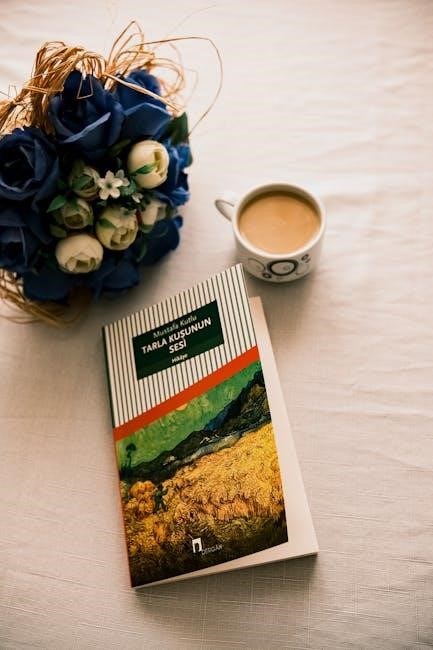
durga saptashati book pdf
The Durga Saptashati, also known as the Chandi Path, is a revered Hindu scriptural text from the Markandeya Purana․ It glorifies Goddess Durga, embodying divine feminine power and strength․
This sacred book is divided into 13 chapters, detailing Durga’s cosmic battles and spiritual significance․ It is a cornerstone of Shaktism, highlighting the triumph of good over evil through divine intervention․
The text is often recited during Navaratri and other sacred rituals, offering devotees spiritual protection, courage, and enlightenment․ Its verses are considered potent tools for worship and self-realization․
In modern times, the Durga Saptashati PDF has become widely accessible, allowing global devotees to connect with its timeless wisdom and spiritual teachings․

1․1 Overview of the Durga Saptashati PDF
The Durga Saptashati PDF is a sacred Hindu text extracted from the Markandeya Purana, comprising 13 chapters that glorify Goddess Durga․ It is a foundational scripture in Shaktism, emphasizing the divine feminine power and its role in maintaining cosmic order․ The text narrates Durga’s legendary battles against demons like Mahishasura, symbolizing the eternal triumph of good over evil․ Its verses are rich with spiritual teachings, rituals, and philosophical insights․ Widely revered, the Durga Saptashati is often recited during Navaratri and other sacred rituals, offering devotees protection, strength, and spiritual enlightenment․ Its PDF format has made it easily accessible globally, preserving its timeless wisdom․
1․2 Significance of the Durga Saptashati in Hindu Scripture
The Durga Saptashati holds immense significance as a core text in Hindu scripture, particularly within the Shaktism tradition․ It is revered for its profound depiction of Goddess Durga as the embodiment of divine feminine power and cosmic energy․ The text intricately weaves themes of spirituality, ritual practices, and the eternal struggle between good and evil․ Its verses are considered potent tools for spiritual growth, offering protection, courage, and enlightenment to devotees․ The Durga Saptashati is also integral to rituals like Navaratri, where its recitation is believed to invoke Durga’s blessings․ Its teachings emphasize the triumph of righteousness and the divine feminine’s role in maintaining cosmic balance․

Origin and Historical Background
The Durga Saptashati originates from the Markandeya Purana, a major Hindu scripture․ It is a 13-chapter text glorifying Goddess Durga, embodying divine strength and cosmic order․
2․1 Ancient Roots of the Durga Saptashati

The Durga Saptashati traces its origins to the ancient Hindu text, the Markandeya Purana, a revered scripture in Hinduism․ Its roots are deeply embedded in Vedic traditions and the worship of the divine feminine․
The text is believed to have evolved over centuries, reflecting the cultural and spiritual practices of ancient India․ It is considered a cornerstone of Shaktism, emphasizing the power of Goddess Durga in maintaining cosmic order and combating evil forces․
2․2 Evolution of the Text Over the Centuries
The Durga Saptashati has undergone significant evolution since its origins in the Markandeya Purana․ Over centuries, it transitioned from oral traditions to written form, with interpretations and additions reflecting changing cultural and spiritual practices․
Regional influences shaped its adaptations, leading to variations in rituals and recitations․ Scholars and sages contributed commentaries, enhancing its theological depth․ Modern translations and digital versions have made it accessible globally, preserving its relevance in contemporary times․
2․3 Key Contributors to the Durga Saptashati
The Durga Saptashati has been shaped by ancient scholars and sages, including Pāṇini and Yaska, whose works reference its origins․ Modern translators and commentators have also played a crucial role in interpreting and popularizing the text․
- Scholars have contributed through detailed analyses and commentaries, enriching its theological understanding․
- Translators have made the text accessible in multiple languages, ensuring its global reach and relevance․
- Spiritual leaders continue to interpret its verses, connecting them to contemporary spiritual practices․
Their collective efforts have preserved the text’s sanctity while adapting it for modern audiences․

Structure and Key Chapters
The Durga Saptashati is structured into 13 chapters within the Markandeya Purana, divided into three sections: Prakartia, Madhyama, and Upari, detailing Durga’s cosmic battles and divine grace․
3․1 The 13 Chapters of the Durga Saptashati
The Durga Saptashati comprises 13 chapters, each narrating distinct episodes of Goddess Durga’s divine interventions․ These chapters are divided into three main sections: Prakartia, Madhyama, and Upari․ The initial chapters introduce Durga’s origin and her first battles, while the middle sections describe her confrontation with powerful demons like Mahishasura․ The final chapters highlight her ultimate victory and the restoration of cosmic order․ Each chapter is rich in spiritual symbolism, offering insights into divine power and the triumph of good over evil, making it a foundational text for devotees seeking enlightenment and protection․
3․2 Summary of Each Chapter’s Content
The Durga Saptashati unfolds over 13 chapters, each detailing pivotal moments in Goddess Durga’s divine journey․ The initial chapters describe her origin and preparation for battle, while the middle sections narrate epic confrontations with demons like Mahishasura, Shumbha, and Nishumbha․ The text vividly portrays Durga’s ferocity and wisdom, emphasizing her role as a protector of the universe․ Later chapters highlight her triumph and the restoration of cosmic balance, while also delving into philosophical themes of divine power and human devotion․ This structured narrative makes the text a comprehensive guide for spiritual seekers and devotees alike․
3․3 The Role of the Three Sections (Prakartia, Madhyama, and Upari)
The Durga Saptashati is divided into three sections: Prakartia, Madhyama, and Upari․ The Prakartia introduces the divine emergence of Goddess Durga, setting the stage for her cosmic battles․ The Madhyama section details her fierce confrontations with demons, showcasing her power and strategy․ The Upari section concludes with her victory, restoring cosmic balance and emphasizing her eternal protection․ Each section builds on the previous, creating a narrative flow that highlights Durga’s role as a protector and symbol of divine feminine energy, offering spiritual insights and inspiration to devotees․

Theological Significance
The Durga Saptashati is a cornerstone of Hindu theology, celebrating the divine feminine as a protector and destroyer of evil, embodying strength and cosmic order․

4․1 The Concept of the Divine Feminine
The Durga Saptashati embodies the divine feminine, personified by Goddess Durga, who symbolizes cosmic energy, protection, and the destruction of evil․ She represents the nurturing yet powerful aspect of the universe, often depicted as a multi-armed warrior riding a lion or tiger․ This concept underscores the idea of femininity as both creative and destructive, maintaining balance and order in the cosmos․ Durga’s divine feminine energy is celebrated as the ultimate protector, vanquishing forces of darkness and chaos, such as Mahishasura, to restore harmony․ Her imagery and stories reinforce the reverence for feminine power in Hindu theology and culture․
4․2 The Battle Between Good and Evil
The Durga Saptashati vividly chronicles the epic battle between Goddess Durga and the buffalo-demon Mahishasura, symbolizing the eternal conflict between good and evil․ This narrative is central to the text, highlighting Durga’s divine intervention to restore cosmic balance․ The battle showcases her unparalleled strength, strategy, and divine grace, ultimately leading to the demon’s defeat․ This legend reinforces the universal truth of righteousness triumphing over adversity, inspiring devotees to embrace courage and moral integrity․ The text’s depiction of this cosmic struggle resonates deeply, offering spiritual guidance and hope for overcoming life’s challenges․
4․3 Symbolism in the Durga Saptashati
The Durga Saptashati is rich in symbolism, where Goddess Durga embodies the divine feminine force, fighting evil to restore balance․ Her lion or tiger mount represents courage and power, while her multiple arms signify omnipresence and multitasking․ The weapons she wields symbolize various divine energies, and her victory over Mahishasura denotes the triumph of good over evil․ The text also uses natural elements like fire and water to illustrate purification and transformation․ These symbols offer deep spiritual insights, guiding devotees toward self-realization and the understanding of cosmic truths, making the text a profound source of wisdom and inspiration․
Navadurga: The Nine Forms of Durga
Navadurga represents nine divine forms of Goddess Durga, worshipped across nine days of Navaratri, each embodying her unique qualities and strengths․

Navadurga, or the nine forms of Goddess Durga, are revered manifestations of her divine power and grace․ Each form symbolizes distinct virtues and strengths, worshipped across nine days of Navaratri․ These forms embody the goddess’s ability to adapt and protect, reflecting her multi-faceted nature․ From Skondamata to Siddhidatri, each incarnation carries unique attributes and stories, celebrating her cosmic battles and spiritual significance․ The Navadurga forms are deeply rooted in Hindu mythology and are central to the rituals and chants in the Durga Saptashati, highlighting her role as a protector and a symbol of divine feminine energy․
5․2 Skondamata: The First Form
Skondamata, the first form of Navadurga, is worshipped on the first day of Navaratri․ She is depicted holding a lotus flower in her hand and riding a lion or an elephant․ Her name derives from the myth of her father, King Himalaya, who gifted her a lotus, symbolizing purity and grace․ Skondamata embodies divine knowledge and wisdom, inspiring devotees to seek enlightenment․ Her serene presence reflects the nurturing aspect of the Divine Mother, making her a cherished figure in Hindu devotion and rituals․
5․3 Kusumanda: The Second Form
Kusumanda is the second form of Navadurga, worshipped on the second day of Navaratri․ Her name, derived from “Kusuma” (flowers) and “Anda” (egg), symbolizes her role in cosmic creation․ She is depicted as a serene, lotus-handed goddess, riding a lion or tiger, embodying life and vitality․ Kusumanda is associated with the cosmic egg, from which the universe emerged, highlighting her creative power․ Her worship is believed to grant health and strength, purifying the mind and body․ This form of Durga represents the nurturing and life-giving aspects of the Divine Mother, inspiring devotion and spiritual growth․
5․4 Shailaputri: The Third Form
Shailaputri, the third form of Navadurga, is revered as the daughter of the Himalayas․ Her name means “Mountain’s Daughter,” symbolizing her origin and strength․ Depicted riding a bull, she embodies calmness and determination․ Shailaputri holds a trident and a lotus, representing her divine power and purity․ She is worshipped on the third day of Navaratri, seeking blessings for marital harmony and spiritual growth․ Her serene presence inspires devotees to embrace inner peace and resilience, reflecting the nurturing aspects of the Divine Mother․ Shailaputri’s worship is believed to grant courage and wisdom, aligning one’s path with divine will․
5․5 Kaalratri: The Fourth Form
Kaalratri, the fourth form of Navadurga, is the embodiment of divine wrath and cosmic energy․ Her name, meaning “Black Night,” reflects her dark complexion and disheveled hair․ Riding a donkey or lion, she symbolizes the destruction of evil forces․ Kaalratri is often depicted with a sword and a dagger, representing her fierce battle against darkness․ Worshipped on the fourth day of Navaratri, she is believed to dispel negative energies and grant inner peace․ Her presence reminds devotees of the transience of life and the triumph of good over evil․ Kaalratri’s worship is a powerful invocation for protection and spiritual awakening․
5․6 Brahmacharini: The Fifth Form
Brahmacharini, the fifth form of Navadurga, embodies severe penance and spiritual discipline․ Clad in a simple white dress, she holds a rosary and a water pot, symbolizing her devotion to knowledge and austerity․ Her name, meaning “one who practices celibacy,” reflects her unwavering commitment to spiritual pursuits․ Worshipped on the fifth day of Navaratri, Brahmacharini is believed to grant boons for marital bliss and progeny․ Her serene yet determined demeanor reminds devotees of the power of self-control and the importance of balancing worldly desires with spiritual aspirations․ Her story, deeply rooted in the Durga Saptashati, inspires seekers to embrace a life of discipline and divine connection․
5․7 Maha Gauri: The Sixth Form
Maha Gauri, the sixth form of Navadurga, is revered for her radiant beauty and compassionate nature․ Her name, meaning “Great White Goddess,” reflects her luminous appearance, often depicted in a white dress, riding a bull․ She embodies purity, peace, and divine grace․ Worshipped on the sixth day of Navaratri, Maha Gauri is believed to protect devotees from negative energies and grant them wisdom, prosperity, and marital harmony․ Her gentle demeanor and nurturing qualities make her a beloved form of Durga․ The Durga Saptashati highlights her significance as a protector and a symbol of transformation, inspiring devotees to seek her blessings for a harmonious and enlightened life․
5․8 Katyayani: The Seventh Form
Katyayani, the seventh form of Navadurga, is celebrated for her fierce warrior spirit and unwavering determination․ She is often depicted riding a lion, symbolizing her unrelenting power and courage․ This form of Durga is associated with the destruction of evil forces and is particularly revered during the seventh day of Navaratri․ Her name, meaning “born of Katya,” reflects her divine origins․ The Durga Saptashati praises Katyayani as a protector who eliminates negativity and grants strength to her devotees․ Worshippers seek her blessings for courage, clarity, and victory over life’s challenges, making her a central figure in Hindu devotion and rituals․
5․9 Chandraghanta: The Eighth Form
Chandraghanta, the eighth form of Navadurga, is revered for her serene yet powerful presence․ She is depicted with a crescent moon on her forehead, symbolizing her radiant and calming energy․ Riding a tiger, Chandraghanta embodies strength and control over negativity․ Her name, meaning “one who wears the moon,” reflects her association with clarity and intuition․ The Durga Saptashati highlights her role in dispelling darkness and ignorance․ Devotees worship her for peace, prosperity, and spiritual growth, seeking her blessings to overcome obstacles and attain inner harmony․ Her grace is believed to bring balance and positivity to those who honor her during Navaratri․
5․10 Siddhidatri: The Ninth Form
Siddhidatri, the ninth form of Navadurga, is the ultimate embodiment of perfection and fulfillment․ She is often depicted sitting on a lotus, symbolizing her detachment from worldly desires․ With four arms, she holds lotuses and blessings, representing her power to grant spiritual and material achievements․ The Durga Saptashati extols her as the granter of siddhis (supernatural powers) and the maintainer of cosmic balance․ Worshiping Siddhidatri during Navaratri is believed to bestow devotees with enlightenment, prosperity, and the realization of their desires․ Her serene presence signifies the culmination of the divine feminine energy, inspiring seekers to attain spiritual liberation and harmony․

Rituals and Practices
The Durga Saptashati is central to Hindu puja rituals, especially during Navaratri․ Chanting its verses offers spiritual protection and blessings․ Its PDF form has made it accessible globally․
6․1 The Role of the Durga Saptashati in Puja Rituals
The Durga Saptashati holds a sacred place in Hindu puja rituals, particularly during Navaratri․ It is chanted to invoke Goddess Durga’s blessings and protection․ The text is recited with precise rituals, offering spiritual cleansing and empowerment․ Many devotees perform path (recitation) of the Saptashati during these nine days to seek divine grace․ Its verses are believed to ward off negative energies and bring prosperity․ The PDF version has made it easier for devotees worldwide to follow the rituals accurately, ensuring the tradition’s continuity in modern times while preserving its ancient spiritual significance․
6․2 Chanting the Saptashati: Benefits and Methods
Chanting the Durga Saptashati is believed to offer profound spiritual benefits, including protection from adversities, inner peace, and divine blessings․ Devotees recite the verses to seek Goddess Durga’s grace, often during Navaratri․ The chanting is typically performed with a rudraksha mala, following specific rituals to enhance its potency․ Regular recitation is said to purify the mind, strengthen faith, and grant spiritual growth․ Proper pronunciation and devotion are emphasized for optimal results․ The PDF version provides easy access to the text, enabling devotees to follow the chants accurately and experience the transformative power of this sacred scripture․
6․3 The Significance of Navaratri in the Durga Saptashati
Navaratri holds immense significance as it commemorates Goddess Durga’s triumph over evil forces, as detailed in the Durga Saptashati․ The nine-day festival corresponds to the nine forms of Durga, with each day dedicated to a specific manifestation․ Devotees recite the Saptashati during these days, often performing rituals like path, havan, and offerings to seek divine blessings․ The text’s verses are chanted to invoke Durga’s protection and strength․ Navaratri celebrations, including Durga Puja, symbolize the eternal victory of good over evil, aligning with the Saptashati’s core themes․ This period is considered auspicious for spiritual growth and connecting with the divine feminine energy․
Cultural Impact
The Durga Saptashati profoundly influences Hindu culture, inspiring art, literature, and traditions․ Its themes of divine feminine power and moral victory shape societal values and spiritual practices globally․
7․1 The Role of the Durga Saptashati in Hindu Culture
The Durga Saptashati holds a pivotal role in Hindu culture, serving as a spiritual and cultural cornerstone․ It is widely recited during Navaratri and other sacred rituals, symbolizing the divine feminine power and the triumph of good over evil․ The text is often depicted in Hindu art and literature, inspiring devotion and moral values․ Its influence extends to festivals, where Durga’s victory over Mahishasura is celebrated with grandeur․ The book’s teachings on strength, protection, and righteousness resonate deeply, shaping societal norms and individual spirituality․ It remains a cultural symbol of empowerment and divine grace, uniting communities in shared reverence and tradition․
7․2 Durga Saptashati in Modern Times
In modern times, the Durga Saptashati remains a vital spiritual text, embracing technological advancements to reach a global audience․ Its digital versions, including PDF formats, have made it accessible to millions, fostering devotion beyond geographical boundaries․ The text is widely shared and studied online, with translations and commentaries catering to diverse linguistic needs․ Modern practitioners often integrate its teachings into daily life, using digital platforms for recitations and discussions․ The rise of e-books and apps has further popularized the Durga Saptashati, ensuring its timeless wisdom continues to inspire contemporary seekers of spiritual growth and enlightenment․
7․3 The Book’s Influence on Art and Literature
The Durga Saptashati has profoundly influenced art and literature, inspiring countless works across centuries․ Its vivid narratives of Durga’s battles and divine essence have shaped temple carvings, paintings, and sculptures․ In literature, the text’s themes of divine femininity and victory over evil have been adapted into poems, plays, and novels․ Modern artists continue to draw from its imagery, creating contemporary interpretations that resonate with global audiences․ The book’s spiritual and cultural richness ensures its enduring impact on creative expression, bridging traditional and modern art forms while preserving its sacred essence for future generations․

Availability and Access
The Durga Saptashati PDF is widely available online, with numerous sources offering free and paid versions․ Digital platforms, religious websites, and e-bookstores provide easy access to this sacred text, ensuring its teachings reach a global audience effortlessly․
8․1 Sources for the Durga Saptashati PDF
The Durga Saptashati PDF can be sourced from various online platforms, including official religious websites, e-commerce sites, and digital libraries․ Many temples and cultural organizations offer free downloads of the text, ensuring accessibility for devotees worldwide․ Additionally, platforms like Amazon and Google Books provide downloadable versions, often with translations and commentaries․ Digital libraries such as archive․org and sacred-texts;com also host the PDF, catering to both scholarly and spiritual audiences․ These sources ensure that the sacred text remains widely available, preserving its teachings for future generations while maintaining its cultural and religious significance․
8․2 Translations and Commentaries
The Durga Saptashati is available in multiple translations, catering to diverse linguistic preferences․ Translations in English, Hindi, Bengali, and other regional languages ensure accessibility for global devotees․ Renowned scholars and spiritual leaders have provided insightful commentaries, enriching the text’s interpretation․ Notable commentators include Swami Satyananda Saraswati and Swami Gambhirananda, whose works offer deep philosophical and spiritual insights․ These translations and commentaries bridge the gap between ancient wisdom and modern understanding, making the text relatable and meaningful for contemporary readers․ They highlight the scriptural significance and practical application of the teachings, fostering a deeper connection with the divine feminine energy embodied by Goddess Durga․
8․3 Digital Versions and Their Popularity
The Durga Saptashati PDF has gained immense popularity in its digital form, making the ancient text accessible to a global audience․ E-books and online platforms offer convenient access, allowing devotees to download and study the scripture anytime, anywhere․ The digital format has also enabled features like adjustable font sizes and search functionality, enhancing readability and usability․ Many spiritual and religious websites provide free downloads, ensuring widespread dissemination․ Additionally, multimedia enhancements such as audio recitations and video explanations have further increased its appeal․ This digital revolution has made the Durga Saptashati more accessible than ever, preserving its timeless wisdom for future generations․
The Durga Saptashati remains a timeless source of spiritual wisdom, offering insights into divine power and cosmic balance․ Its digital availability ensures its teachings reach global seekers, preserving its sacred legacy․
9․1 Summary of the Durga Saptashati’s Importance
The Durga Saptashati holds profound significance as a foundational text of Shaktism, celebrating Goddess Durga’s divine power and cosmic battles․ Its 13 chapters narrate her triumph over evil forces, symbolizing the eternal victory of good over evil․ The book is a spiritual guide, offering insights into divine feminine energy, moral strength, and the destruction of negative forces․ It is widely revered for its ritualistic significance, particularly during Navaratri, and its teachings continue to inspire devotion and self-reflection․ The Durga Saptashati PDF has made this sacred text accessible globally, ensuring its timeless wisdom endures for future generations․
9․2 Final Thoughts on the Book’s Relevance
The Durga Saptashati remains a timeless spiritual treasure, offering profound insights into divine power, moral strength, and the triumph of good over evil․ Its relevance extends beyond religious rituals, inspiring modern seekers with universal themes of courage and resilience․ The text’s accessibility in PDF format has broadened its reach, making it a valuable resource for global audiences․ As a celebration of the divine feminine, it continues to empower individuals, fostering spiritual growth and a deeper connection to Hindu heritage․ Its enduring appeal lies in its ability to transcend time, providing solace, wisdom, and inspiration to readers worldwide․